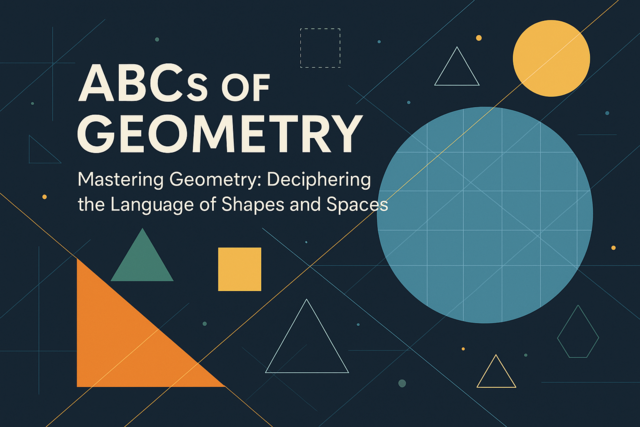Online Class: Geometry 101 — Beginner to Intermediate Level

no certificate
with CEU Certificate*
-
15Lessons
-
38Exams &
Assignments -
3,454Students
have taken this course -
17Hours
average time -
1.7CEUs
Course Description
Imagine a world without shape or form, where chaos reigns, and the beauty of symmetry is absent. It's our uncanny ability to interpret the language of geometry that disentangles our perception and breathes order into our universe. Geometry 101 is not merely a course; it's an odyssey through the mathematical symphony that orchestrates the dance of points, lines, and planes, transforming the abstract into the tangible. This course is your gateway to unraveling the vast tapestry of spatial intelligence and leveraging it to enrich every facet of your life.
Step forward into a world where walls whisper stories of angles, where streets and skyscrapers pulse with the logic of lines and shapes. With Geometry 101, you are about to embark on an unforgettable journey, where your guide is not just knowledge, but the power to see the world through a lens of elegance and precision that only geometry can provide.
Each unit of this immersive course is crafted meticulously to weave a seamless tapestry from the rudiments of geometric principles to the nuanced symphony of spatial reasoning. You will begin your exploration with simple points and lines, nurturing your innate curiosity about how these simple constructs form the essence of everything. Soon, you will find yourself navigating the complex interplay of angles and intersections, developing the keen eye necessary to recognize the universe's subtle geometric rhythm.
Venturing into the realm of polygons, you will unravel the mystique of triangles and quadrilaterals, breathing life into these foundational forms. You'll learn to harness their properties, cultivating an understanding as timeless as the pyramids, as profound as the humble honeycomb's hexagonal perfection. This mastery will elevate your capacity to seamlessly transition to the more sophisticated art of constructing and deconstructing composite shapes--an architectural dance of creativity and logic.
The journey doesn't stop at two dimensions. With Geometry 101, you transcend the boundaries of the flat surface. Our exploration ascends into three-dimensional space, offering profound insights into the solid realities of spheres, polyhedra, and the kaleidoscopic interplay of planes. Learn to dissect complexity with clarity and precision, as you unravel the mysteries of volumes and surfaces that define not just objects but the very nature of the space they inhabit.
But why merely follow others? Why not grasp the reins of your geometric destiny and conjure your own constructs? Geometry 101 equips you with this power, taking you beyond theoretical realms to the time-honored art of classical construction. With a compass and straightedge, your sketches evolve from rudimentary lines to masterpieces of innovation and precise beauty--a dance of geometry that transcends mere calculation.
Geometry 101 isn't just about learning; it's about transformation. It's about cultivating a mindset that recognizes the unseen bonds between the abstract world of numbers and the tactile experiences of reality. By the end of this course, you'll possess not only the mathematical prowess to solve geometric conundrums but the confidence to apply this knowledge in real-world scenarios. Your newfound skills in trigonometry will embolden you to navigate a world layered with geometric challenges, whether in technology, design, or day-to-day problem-solving.
Choose Geometry 101 and don't just study geometry--inhabit it. Let it reshape your perspective, refine your talents, and redefine excellence. This course is not just an educational endeavor but the laying of fertile ground where curiosity flowers into mastery. Let Geometry 101 steer you toward the future you're dreaming of--join us, and transform the way you see, think, and shape the world around you. The path to enlightenment is geometric; let yours begin here.
- Completely Online
- Self-Paced
- 6 Months to Complete
- 24/7 Availability
- Start Anytime
- PC & Mac Compatible
- Android & iOS Friendly
- Accredited CEUs

Course Lessons
Lesson 1. Foundations of Geometry and Their Practical Applications
Understanding geometry enhances problem-solving skills for both practical and academic purposes, across diverse areas like designing, construction, and scientific inquiry. This lesson provides foundational definitions of geometric figures, such as points and lines, which are essential for further study and applications.Lesson 2. Deductive Reasoning: A Deep Dive into Geometry
Exploring deductive reasoning in geometry, this lesson covers deriving conclusions from premises, using logical if-then statements, and conducting proofs by contradiction. Additionally, it discusses using arbitrary units for measurement and understanding the significance of dimensions such as length, area, and volume.Lesson 3. Angles and Parallel Lines in Geometry
In this lesson, angles are introduced and classified by size, demonstrating how intersecting lines can form multiple angles and highlighting the properties of vertical and supplementary pairs. Parallelism is defined through the interaction of angles when a transversal cuts across parallel lines, leading to the identification of corresponding angles.Lesson 4. Decoding the Secrets of Triangles: Types and Properties
Triangles are three-sided polygons characterized by non-coincident, non-parallel lines, where the sum of the angles adds up to 180 degrees, which we proved through angle properties derived from parallel lines and transversals. This lesson covers various triangle types and introduces right triangles, their properties, and methods to calculate areas, preparing students to explore triangle congruence and similarity.Lesson 5. Mastering Congruent Triangles: A Study of Geometric Similarities
The lesson elucidates criteria such as SSS that confirm triangle congruence, showing how certain side and angle pairings prove triangle identity. By concentrating on congruence, learners enhance their ability to pinpoint identical triangles amidst complex figures.Lesson 6. Triangles and Transformation: Discovering Similarity
This lesson enriches students' understanding of triangle similarity, highlighting the use of transformations and three proportionality-based conditions. By utilizing transformations like dilation, students can prove triangle similarity, even when congruence is not present.Lesson 7. Quadrilaterals Unlocked: From Basic Shapes to Calculating Areas
Lesson Summary 2: This lesson delves into quadrilaterals, explaining their basic properties and differentiating between subcategories like trapezoids and parallelograms based on parallel sides and angles. Utilizing the properties of triangles, students learn to compute areas of various quadrilateral types, reinforcing geometric understanding through formulas and examples.Lesson 8. Polygon Perimeters and Properties
Building on basic three- and four-sided figures, the lesson delves into the world of n-sided polygons, offering techniques for calculating perimeter and interior angles. Using subdivision, complex polygons can be broken down for easier analysis and understanding.Lesson 9. Understanding Circles: Essential Concepts and Calculations
Focusing on circles, this lesson distinguishes them from polygons by exploring equidistant points from a center, defining key elements such as radius and diameter, and utilizing degree measurements to understand arcs and sectors. It provides formulas for calculating circumference and area, introducing the crucial mathematical constant ?.Lesson 10. Exploring the World of Composite Figures: An Analytical Journey
Composite figures, which are combinations of simpler shapes, require a methodical approach of division into basic parts to determine characteristics like area and perimeter. The lesson hones skills in breaking down complex shapes for analysis, making use of known geometric properties.Lesson 11. Pencil and Compass: The Art of Classical Constructions
With the use of a compass, straightedge, and pencil, this lesson guides students through classical geometric constructions, emphasizing the lasting relevance and precision of these fundamental techniques. As students engage with bisecting lines and angles, they gain a deep appreciation for the craftsmanship of geometry beyond modern computation.Lesson 12. Hands-On Geometry: Applying What You've Learned
This lesson introduces practical geometry applications by outlining problem-solving steps, using scenarios like calculating composite floor areas and solving practice exercises with diagrams and measurements. Emphasizing unit awareness and triangle congruence, it reinforces using geometric relationships to simplify real-world problems.Lesson 13. Parallelism and Perpendicularity Beyond Two Dimensions
Examining the intricacies of three-dimensional geometry, this lesson presents concepts like skew lines and multiple parallel planes that elevate the understanding of spatial relationships. Visual representation techniques and cross sections are key tools provided to facilitate the comprehension of 3D structures on 2D surfaces.Lesson 14. Advanced Exploration of Polyhedra and 3D Shapes: Volume and Surface Analysis
Lesson Summary 3: Lesson 14 deepens the understanding of three-dimensional shapes by highlighting the measures of volume and surface area, focusing specifically on polyhedra, spheres, and cylinders. The lesson equips learners with tools to effectively compute and solve practice problems involving both standalone and composite geometric figures.Lesson 15. Introduction to Trigonometry: Understanding Angles and Sides
The lesson connects the intricate elements of trigonometry with geometry, using sine, cosine, and tangent to unravel the symmetrical mysteries of right triangles and their relation to circles. Mastery here equips you with a robust framework for solving diverse geometric problems, expanding your mathematical toolkit beyond basic formulas.
Learning Outcomes
- Identify and describe fundamental geometric figures such as points, lines, rays, and planes by illustrating them accurately with examples.
- Recognize the importance of geometry in daily life, academia, and professional settings by providing three examples of practical applications.
- Define deductive reasoning and demonstrate deriving conclusions from given premises.
- Explain the importance of units in geometric measurement and demonstrate using arbitrary units for measurement.
- Recognize and construct a two-column proof for basic geometric problems.
- Demonstrate understanding of angle relationships and properties when a transversal intersects two parallel lines.
- Identify and calculate the measures of angles formed by intersecting lines using degree measurements.
- Calculate the length of a side in a right triangle using the Pythagorean theorem.
- Identify and classify triangles as equilateral, isosceles, or scalene based on side lengths and angles.
- Demonstrate congruence between two triangles using the hypotenuse-leg (HL) condition in right triangles.
- Recognize and justify the four conditions (SSS, SAS, ASA, AAS) for triangle congruence through geometric reasoning.
- Prove the similarity of any two given triangles by applying the appropriate conditions such as angle-angle, side-side-side proportionality, or side-angle-side proportionality.
- Demonstrate how to use geometric transformations to show two triangles are similar, including dilation and translation, within a structured problem-solving process.
- Demonstrate mastery of lesson content at levels of 70% or higher.
Additional Course Information

- Document Your Lifelong Learning Achievements
- Earn an Official Certificate Documenting Course Hours and CEUs
- Verify Your Certificate with a Unique Serial Number Online
- View and Share Your Certificate Online or Download/Print as PDF
- Display Your Certificate on Your Resume and Promote Your Achievements Using Social Media

Choose Your Subscription Plan
No Certificate / No CEUs
This course only
| Includes certificate | X |
| Includes CEUs | X |
| Self-paced |

|
| Instructor support |

|
| Time to complete | 6 months |
| No. of courses | 1 course |
Certificate & CEUs
This course only
| Includes certificate |

|
| Includes CEUs |

|
| Self-paced |

|
| Instructor support |

|
| Time to complete | 6 months |
| No. of courses | 1 course |
Certificates & CEUs
Includes all 600+ courses
| Includes certificate |

|
| Includes CEUs |

|
| Self-paced |

|
| Instructor support |

|
| Time to complete | 12 Months |
| No. of courses | 600+ |
Certificates & CEUs
Includes all 600+ courses
| Includes certificate |

|
| Includes CEUs |

|
| Self-paced |

|
| Instructor support |

|
| Time to complete | 24 Months |
| No. of courses | 600+ |
Student Testimonials
- "Course was a bit difficult for me, instructor was available and helped me when I needed help!" -- Marcus M.
- "This was a great course. I learned a lot about Geometry and am excited to use what I learned here in my high school. It was definitely better than some of the other Universal courses I took because this instructor, Mr. Clark, was more organized and thorough with his lessons, and it was easier to understand him than other university's instructors." -- Hannah Z.
- "He was an excellent teacher...the lessons were very clear and easy to understand. I also like the 15 lesson layout." -- Rayna K.
Related Courses
-
 7 hours
0.7 CEUs
Organizational Behavior in Business
+ More Info
7 hours
0.7 CEUs
Organizational Behavior in Business
+ More Info
-
 6 hours
0.6 CEUs
Sustainable Development for Business
+ More Info
6 hours
0.6 CEUs
Sustainable Development for Business
+ More Info
-
 4 hours
0.4 CEUs
Business Analysis
+ More Info
4 hours
0.4 CEUs
Business Analysis
+ More Info
-
 8 hours
0.8 CEUs
Teaching Grammar to ESL Students
+ More Info
8 hours
0.8 CEUs
Teaching Grammar to ESL Students
+ More Info
-
 12 hours
1.2 CEUs
Business Math 101
+ More Info
12 hours
1.2 CEUs
Business Math 101
+ More Info
-
 7 hours
0.7 CEUs
Introduction to Logic
+ More Info
7 hours
0.7 CEUs
Introduction to Logic
+ More Info






